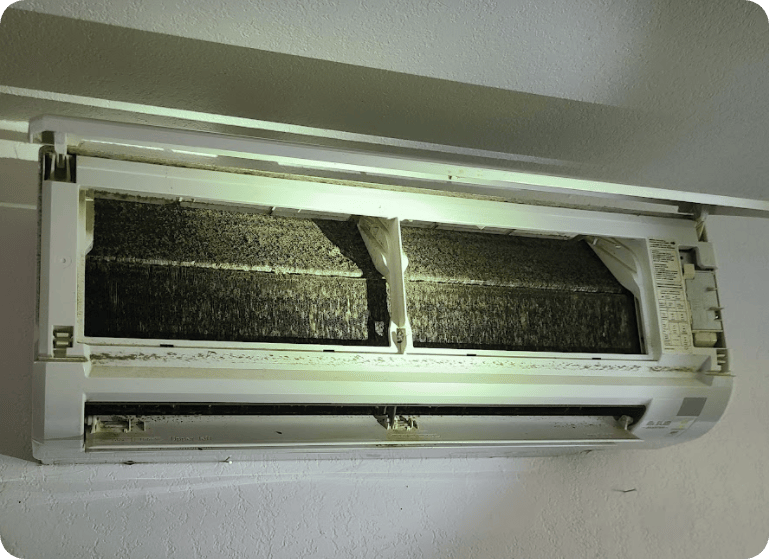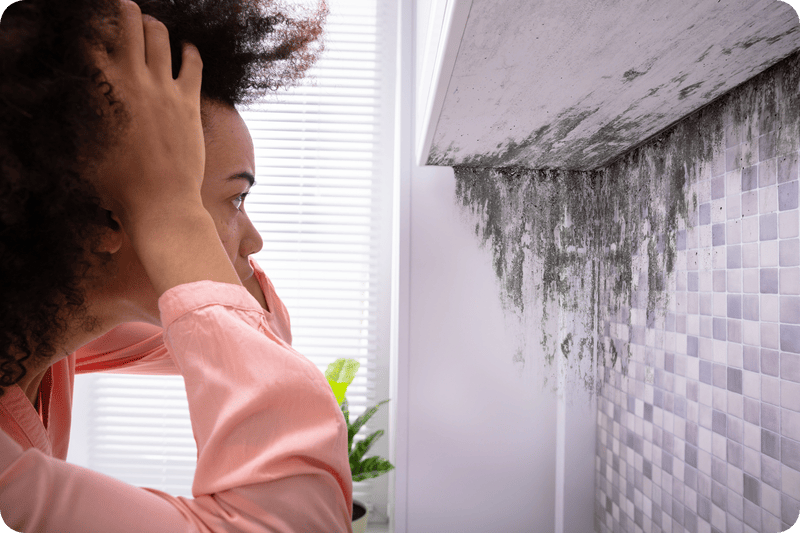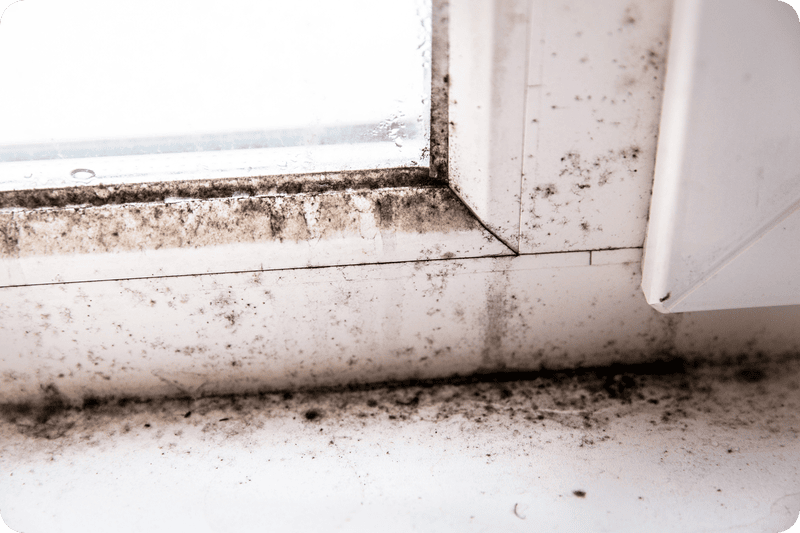Mold Toxicity And The Signs That Mold Is Making You Sick
Yes, Mold Toxicity Can Make You Feel Sick. Here Are The Signs.

Mold toxicity is a somewhat controversial diagnosis. But, whether it’s the most accurate name for the problem doesn’t change this fact: Yes, being around mold can make you feel sick. And the symptoms can become severe after prolonged exposure.
But, many doctors don’t like to use the term “mold toxicity” because the exact problem is hard to pin down.
As you’ll learn in this article, the symptoms of mold toxicity are not unique. Instead, they mimic the symptoms of many other health problems.
Some people will develop flu-like symptoms or appear to suffer from seasonal allergies. More severe symptoms, like vertigo or digestive issues, are often caused by other underlying problems. The same goes for neurological conditions that may manifest after prolonged exposure.
Related: Symptoms And Warning Signs Of Mold Toxicity Or Poisoning
So, how do you know if your symptoms stem from mold toxicity? And, why are we talking about this on an HVAC website? ‘
We’ll address that first question throughout the rest of the article. As for the second question: As the global leader for mini split cleaning, our HydroKleen208 techs encounter a lot of mold in people’s homes and businesses.
And, they’ve seen the effects it has on homeowners, tenants, and employees.
Sometimes, people call us because they know there’s a mold problem specifically, or just that the air in their home feels dirty or unhealthy. Other times, we get a call because their ductless system isn’t working right, and we discover a mold problem.
In fact, mold is a bigger problem for mini splits than many people realize — another point we’ll get into in this article.
If you have any questions or concerns about the ductless system or indoor air quality in your Treasure Valley home or business, call HydroKleen208 at (208) 779-556 for a free consultation.
What Is Mold Toxicity?
Mold toxicity is an illness caused by exposure to biotoxins in mold spores. The symptoms become chronic, meaning they don’t get better when a person is no longer near toxic mold. They range from physical ailments to psychological and neurological issues.
The medical community is divided about whether mold toxicity is real. Plenty of evidence points to it being a legitimate health concern.
But, some professionals say it’s a misdiagnosis as the symptoms mimic many other health issues. Or that it’s better defined by other, more established terms, which we’ll explore here.
Mold Toxicity Vs. Mold Allergy
Some people are allergic to mold the way others are to pollen. Their immune systems overreact to the spores, causing itchy eyes, coughing, wheezing, a stuffy nose, and other common allergy symptoms. They may also develop rashes.
People with asthma will also experience asthma attacks or trouble breathing — another reason why it’s essential to keep your home clear of mold spores that you can breathe in.
Related: Excellent Indoor Air Quality At Home Is Crucial For People With Asthma
But, unlike mold toxicity, an allergy doesn’t result in chronic symptoms. Instead, they go away once the person isn’t around the mold anymore.
10 Early Warning Signs Of Mold Toxicity
The symptoms and early warning signs of mold toxicity are often confused with other problems. But if you’re experiencing many of these problems, mold may be the cause:
- Itchy, Watery Eyes
- Headaches
- Wheezing Or Asthma Attacks
- Frequent Coughing
- Hives Or Rashes
- Episodes Of Vertigo
- Diarrhea, Nausea, And Abdominal Pain
- Metallic Tights In Your Mouth
- ” Brain Fog” Or Trouble Concentrating
- Joint Pain, Aches, Or Muscle Cramps
Related: How Long Before Black Mold Kills You?
As you can see, these symptoms may start with mild respiratory issues and extend to headaches and rashes also caused by a mold allergy. But, they become much more severe, including digestive issues and physical and neurological problems.
If you suspect a mold problem in your home and experience these symptoms, see your doctor right away. Next, call a mold specialist to test your home for the presence of spores.
You’ll want to alleviate your symptoms while also getting to the root of the problem.
And, if you have a ductless mini split in your home, the problem may be coming from your heating and cooling system.
Common Mold Problems With Ductless Mini Splits
Mini splits provide excellent, customizable, and energy-efficient comfort in a single room or throughout your home. But, the downside is that they’re often filled with mold spores that end up in the air you breathe every day.
Here’s the problem: Mold requires dark, warmth, and moisture to grow. The insides of your air handlers meet all three conditions.
Sunlight doesn’t reach in there. And, the electronics plus the heat in the air keep it warm. Finally, there’s moisture from water vapor, especially when the system dehumidifies the summer air.
The result? A coil inside in an air handler looking like this:

That’s an actual photo from one of our cleanings here in Cascade. All that microbial buildup results in mold spores, bacteria, and other junk circulating in the room.
It’s why the homeowner called us in the first palace: The air felt “stale,” she said, and she was starting to feel sick at home.
Fortunately, HydroKleen208 specializes in cleanings that are explicitly designed for this problem. Our customized tools and especially-made, non-toxic cleaning agents eradicate all the buildup in your air handler and heat pump in one easy visit.
It’s quick, inexpensive, and there’s no mess. And the results are instant: Once we turn the mini split back on, you’ll notice that the air coming out of it feels cleaner.
Related: How Often Should A Mini Split Be Cleaned?
And, if you want to go behind the scenes, here’s a picture of another coil. In this case, we cleaned half and left it partially dirty so the homeowner could see the difference we made:

Mini Split Cleaning In Cascade, ID
HydroKleen208 offers the most comprehensive and effective mini split cleaning for homes and businesses in Cascade, ID and as far south as Boise Metro. We guarantee our process flushes out all the dirt, dust, and microbial contamination in your system. If you don’t notice a difference, your cleaning is free. Click below or call (208) 779-5596 to learn more.

 Heat pumps require regular maintenance, just like a conventional heating and cooling system. But what does that mean, exactly? And, what difference does it make?
Heat pumps require regular maintenance, just like a conventional heating and cooling system. But what does that mean, exactly? And, what difference does it make? Are you tired all the time? If so, you’re not alone — especially not today.
Are you tired all the time? If so, you’re not alone — especially not today.  Sudden dizziness. Problems focusing or keeping your balance. Nausea. Sweating. Sudden hearing loss. The room feels like it’s spinning around you. Could the culprit be mold? The answer may surprise you.
Sudden dizziness. Problems focusing or keeping your balance. Nausea. Sweating. Sudden hearing loss. The room feels like it’s spinning around you. Could the culprit be mold? The answer may surprise you. Vertigo isn’t a disease itself. Instead, it’s a
Vertigo isn’t a disease itself. Instead, it’s a  Most mold remediation, or removal, projects take between one and five days. The timeline and scope of the work depend on how much mold there is, what it’s growing on, and where it’s located.
Most mold remediation, or removal, projects take between one and five days. The timeline and scope of the work depend on how much mold there is, what it’s growing on, and where it’s located. The ideal temperature range for mold to grow in your home is 77 and 86 degrees Fahrenheit. Keeping the house cooler than that prevents growth. But, temperature is only one factor in spores or other organic toxins cultivating.
The ideal temperature range for mold to grow in your home is 77 and 86 degrees Fahrenheit. Keeping the house cooler than that prevents growth. But, temperature is only one factor in spores or other organic toxins cultivating. In general, the sweet spot for relative humidity in a home is between 30 and 60. No higher than 50 is ideal. That’s the range where mold won’t grow quickly. It also makes your home less attractive to cockroaches and other insects.
In general, the sweet spot for relative humidity in a home is between 30 and 60. No higher than 50 is ideal. That’s the range where mold won’t grow quickly. It also makes your home less attractive to cockroaches and other insects.